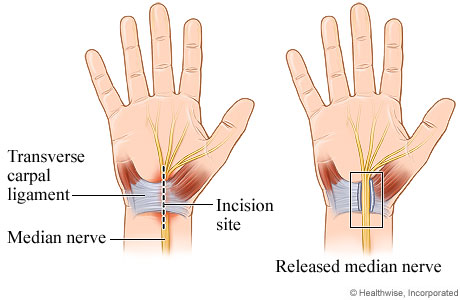Open Carpal Tunnel Surgery
Surgery Overview
During open carpal tunnel release surgery, the transverse carpal ligament is cut. This releases pressure on the median nerve and relieves the symptoms of carpal tunnel syndrome.
An incision is made at the base of the palm of the hand. This allows the doctor to see the transverse carpal ligament. After the ligament is cut, the skin is closed with stitches. The gap where the ligament was cut is left alone. Over time, it fills up with scar tissue.
Most people who have this surgery don't need to stay in the hospital. It is usually done with local anesthetic, and you can go home on the same day.
How It Is Done

In open carpal tunnel release surgery, the transverse carpal ligament is cut, releasing the median nerve. The size and shape of the incision may vary.
What To Expect
After surgery, the hand is wrapped. The stitches are removed 1 to 2 weeks after surgery. The pain and numbness may go away right after surgery or may take several months to subside. Try to avoid heavy use of your hand for up to 3 months.
How soon you can go back to work depends on the type of surgery you had, whether the surgery was on your dominant hand (the hand you use most), and your work activities.
If you had open surgery on your dominant hand and you do repeated actions at work, you may be able to go back to work in 6 to 8 weeks. Repeated motions include typing or assembly-line work. If the surgery was on the other hand and you don't do repeated actions at work, you may be able to go back to work in 7 to 14 days.
Why It Is Done
Open carpal tunnel surgery is considered when:
- You still have symptoms after a long period of nonsurgical treatment. In general, surgery is not considered until after several weeks to months of nonsurgical treatment. But this assumes that you still have symptoms but there's no sign of nerve damage. Nerve damage would make surgery more urgent.
- Severe symptoms (such as persistent loss of feeling or coordination in the fingers or hand, or no strength in the thumb) restrict normal daily activities.
- There is damage to the median nerve (shown by nerve test results and loss of hand or finger function), or a risk of nerve damage.
- Tumors or other growths need to be removed.
How Well It Works
Most people who have surgery for carpal tunnel syndrome have fewer or no symptoms of pain and numbness in their hand after surgery.footnote 1
In rare cases, the symptoms of pain and numbness may come back. (This is the most common complication.) Or you may have short-term loss of strength when you pinch or grip an object. This is because the transverse carpal ligament was cut.
If the thumb muscles have been severely weakened or wasted away, your hand strength and function may be limited even after surgery.
Both endoscopic and open carpal tunnel release have benefits and risks. Studies don't show that one procedure is better than the other in the long term.footnote 2
Risks
The risk and complication rates of open surgery are very low. Major problems such as nerve damage happen in fewer than 1 out of 100 surgeries (less than 1%).footnote 3 There is a small risk that the median nerve or other tissues may be damaged during surgery.
After open surgery, recovery may be slower than after endoscopic surgery. And there may be some pain in the wrist and hand. You may also have some tenderness around the scar. There are also the risks of any type of surgery, including possible infection and risks of general anesthesia. But most open carpal tunnel surgery is done with local anesthesia or regional block rather than with general anesthesia.
References
Citations
- Li Y, et al. (2020). Open versus endoscopic carpal tunnel release: A systematic review and meta-analysis of randomized controlled trials. BMC Musculoskeletal Disorders, 21(1): 272. DOI: 10.1186/s12891-020-03306-1. Accessed September 20, 2022.
- Chen L, et al. (2014). Effectiveness and safety of endoscopic versus open carpal tunnel decompression. Archives of Orthopaedic and Trauma Surgery, 134(4): 585–593. DOI: 10.1007/s00402-013-1898-z. Accessed September 20, 2022.
- Vasiliadis HS, et al. (2014). Endoscopic release for carpal tunnel syndrome. Cochrane Database of Systematic Reviews(1): CD008265. DOI: 10.1002/14651858.CD008265.pub2. Accessed September 20, 2022.
Credits
Current as of: July 24, 2025
Author: Ignite Healthwise, LLC Staff
Clinical Review Board
All Ignite Healthwise, LLC education is reviewed by a team that includes physicians, nurses, advanced practitioners, registered dieticians, and other healthcare professionals.
Current as of: July 24, 2025
Author: Ignite Healthwise, LLC Staff
Clinical Review Board
All Ignite Healthwise, LLC education is reviewed by a team that includes physicians, nurses, advanced practitioners, registered dieticians, and other healthcare professionals.


